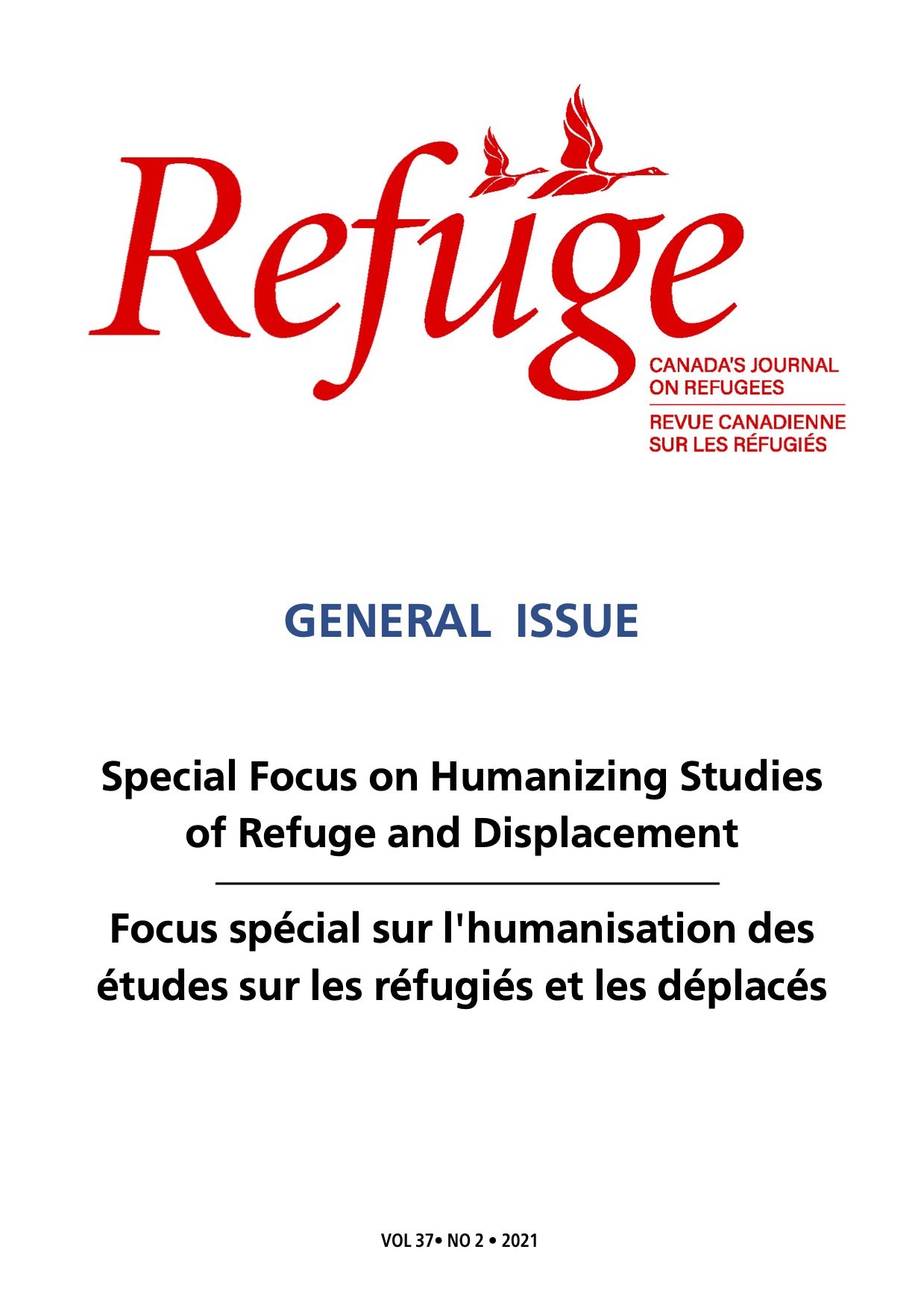“Is it Commerce?”: Dehumanization in the Framing of Refugees as Resources
DOI :
https://doi.org/10.25071/1920-7336.40796Mots-clés :
dehumanization, animalization, refugees-as-resources, discourse analysis, raceRésumé
L’idée selon laquelle les réfugiés constituent des ressources» a été prônée afin de contrer le cadrage déshumanisant des réfugiés comme des fardeaux ou comme une menace sécuritaire. Mais le cadrage des personnes comme ressources n’est-il pas réellement Les théoriciens des ressources ont souligné que les conceptions modernes occidentales de ce que constituent des ressources repose sur la distinction entre l’humain et le non-humain. Cette logique est similaire à la hiérarchisation racialisée de l’humanité et trouve son origine à la même époque. L’évaluation et la gestion du travail humain et de la mobilité par l’État continuent d’être façonnées par la race» et par la perception de la valeur productive en termes économiques, tout comme la valeur accordée aux ressources varie et a toujours été sociale et politique. Cette intervention met en lumière la perspective d’un réfugié burundais en Tanzanie qui retrace la continuité entre des expériences d’animalisation et le fait d’être traité comme une ressource - en ce qu’une ressource peut être vendue ou échangée sans être consultée sur son avenir. Il est vrai que les réfugiés contribuent de manière significative aux communautés et aux pays où ils vivent, mais le prisme des ressources» pose des limites à une perspective réellement sur la vie des réfugiés.
Statistiques
Références
Betts, A., & Collier, P. (2017). Refuge: Transforming a broken refugee system. Penguin Random House.
Brankamp, H. (2021). Camp abolition: Ending carceral humanitarianism. Antipode. Advance online publication. https://doi.org/10.1111/anti.12762
Brankamp, H., & Daley, P. (2020). Laborers, migrants, refugees. Migration and Society, 3(1), 113–129. https://doi.org/10.3167/arms.2020.030110
Bridge, G. (2009). Resources. In D. Gregory, R. Johnston, G. Pratt, M. J. Watts, & S. Whatmore (Eds.), Dictionary of human geography (5th ed., pp. 648–649). Wiley-Blackwell.
Crawley, H. (2017). Migration: Refugee economics [Review of the book Refuge: Transforming a broken refugee system, by A. Betts & P. Collier]. Nature, 544, 26–27. https://doi.org/10.1038/544026a
Daley, P. (1989). Refugees and underdevelopment in Africa: The case of Barundi refugees in Tanzania [Doctoral dissertation, University of Oxford]. Oxford University Research Archive. https://ora.ox.ac.uk/objects/uuid:61d14ce2-4a9c-4a13-9a56-6360094cf502
Daley, P. (2007). Gender & genocide in Burundi: The search for spaces of peace in the Great Lakes Region. James Currey.
Fiddian-Qasmiyeh, E. (2020). Introduction: Refuge in a moving world: Refugee and migrant journeys across disciplines. In E. Fiddian-Qasmiyeh (Ed.), Refuge in a moving world: Tracing refugee and migrant journeys across disciplines (pp. 1–19). UCL Press.
Gilmore, R. W. (2017). Abolition geography and the problem of innocence. In G. T. Johnson & A. Lubin (Eds.), Futures of Black radicalism (pp. 225–240). Verso.
Harrell-Bond, B. (1995). Refugees and the international system: The evolution of solutions. Oxford Refugee Studies Centre. https://www.rsc.ox.ac.uk/files/files-1/rr-refugees-international-system-1995.pdf
Harrell-Bond, B. (2002). Can humanitarian work with refugees be humane? Human Rights Quarterly, 24, 51–85. http://www.jstor.org/stable/20069589
Haslam, N., Loughnan, S., & Sun, P. (2011). Beastly: What makes animal metaphors offensive? Journal of Language and Social Psychology, 30(3), 311–325. https://doi.org/10.1177/0261927x11407168
Hyndman, J. (2000). Managing displacement: Refugees and the politics of humanitarianism. University of Minnesota Press.
Hyndman, J., & Reynolds, J. (2020). Beyond the global compacts: Re-imagining protection. Refuge: Canada’s Journal on Refugees, 36(1), 66–74. https://doi.org/10.25071/1920-7336.40768
Institute for Geographies of Justice JHB 2015. (2015, August 3). RUTH WILSON GILMORE [Video]. YouTube. https://www.youtube.com/watch?v=dmjgPxElk7A&t=3046s
Johnston, R. (2009). Race. In D. Gregory, R. Johnston, G. Pratt, M. Watts, & S. Whatmore (Eds.), Dictionary of human geography (5th ed., pp. 615–617). Wiley-Blackwell.
Kyriakides, C., Taha, D., Charles, C. H., & Torres, R. D. (2019). Introduction: The racialized refugee regime. Refuge: Canada’s Journal on Refugees, 35(1), 3–7. https://doi.org/10.7202/1060670ar
Masabo, J., Kweka, O., Boeynik, C., & Falisse, J.-B. (2018). Socio-economic assessment in the refugees camps and hosting districts of Kigoma region. UNHCR. https://reliefweb.int/report/united-republic-tanzania/socio-economic-assessment-refugee-camps-and-hosting-districts-kigoma
Morris, J. C. (2019). Violence and extraction of a human commodity: From phosphate to refugees in the Republic of Nauru. The Extractive Industries and Society, 6(4), 1122–1133. https://doi.org/10.1016/j.exis.2019.07.001
Mullings, B. (2017). Race, work, and employment. In International encyclopedia of geography (pp. 1–13). John Wiley & Sons. https://doi.org/10.1002/9781118786352.wbieg0660
Ramsay, G. (2020). Humanitarian exploits: Ordinary displacement and the political economy of the global refugee regime. Critique of Anthropology, 40(1), 3–27. https://doi.org/10.1177/0308275X19840417
Schmitt, G. (2017). Avoiding a lost generation of refugees through jobs and education [Press release]. World Economic Forum. https://www.weforum.org/press/2017/05/avoiding-a-lost-generation-of-refugees-through-jobs-and-education/
Skoll.org. (2016). Alexander Betts: “Refugees as a resource” | Skoll World Forum 2016 [Video]. YouTube. https://www.youtube.com/watch?v=1tiYqc_B3c4&list=PLHao2fgbzdxL8PmhIxaqmInOdqMhc41hn&index=9
TUKI (Taasisi ya Uchinguzi wa Kiswahili) (Ed.). (2000). Kamusi ya Kiswahili–Kiingereza (Swahili–English Dictionary). University of Dar es Salaam.
Turner, L. (2019). “#Refugees can be entrepreneurs too!” Humanitarianism, race, and the marketing of Syrian refugees. Review of International Studies, 46(1), 137–155. https://doi.org/10.1017/s0260210519000342
Turner, S. (2004). Under the gaze of the “big nations”: Refugees, rumours and the international community in Tanzania. African Affairs, 103(411), 227–247. https://doi.org/10.1093/afraf/adh006
Vaughan-Williams, N. (2015). “We are not animals!” Humanitarian border security and zoopolitical spaces in Europe. Political Geography, 45, 1–10. https://doi.org/10.1016/j.polgeo.2014.09.009
Whitaker, B. E. (1999). Changing opportunities: Refugees and host communities in western Tanzania (New Issues in Refugee Research, Working Paper No. 11). UNHCR. https://www.unhcr.org/3ae6a0c70.pdf
Wynter, S. (2003). Unsettling the coloniality of being/power/truth/freedom: Towards the human, after man, its overrepresentation—An argument. The New Centennial Review, 3(3), 257–335. https://doi.org/10.1353/ncr.2004.0015
Zamore, L. (2018). Refugees, development, debt, austerity: A selected history. Journal on Migration and Human Security, 6(1), 26–60. https://doi.org/10.1177/233150241800600102
Téléchargements
Publié-e
Versions
- 2021-11-22 (2)
- 2021-11-22 (1)
Comment citer
Numéro
Rubrique
Licence
© Yolanda Weima 2021

Cette œuvre est sous licence Creative Commons Attribution - Pas d'Utilisation Commerciale 4.0 International.
Les auteurs qui publient dans Refuge conservent le droit d’auteur associé à leur œuvre, et octroient au public une licence Creative Commons Attribution - Utilisation non commerciale 4.0 International. La licence permet l’utilisation, la reproduction et l’adaptation du matériel avec attribution par tous moyens et sous tous formats pour des fins non commerciales. Pour des informations générales sur les licences Creative Commons, visitez le site Creative Commons. Pour la licence CC BY-NC 4.0, consultez le résumé lisible par l'homme.







